Abstract
Ecological drought in terrestrial systems is a vegetation-functional degradation phenomenon triggered by the long-term imbalance between ecosystem water supply and demand. This process involves nonlinear coupling of multiple climatic factors, ultimately forming a compound ecological stress mechanism characterized by spatiotemporal heterogeneity. Based on meteorological and remote sensing datasets from 1982 to 2022, this study identified the spatial distribution and temporal variability of ecological drought in China, elucidated the dynamic evolution and return periods of typical drought events, unveiled the scale-dependent effects of climatic factors under both univariate dominance and multivariate coupling, as well as deciphered the response mechanisms of ecological drought to meteorological drought. The results demonstrated that (1) terrestrial ecological drought in China exhibited a pronounced intensification trend during the study period, with the standardized ecological water deficit index (SEWDI) reaching its minimum value of −1.21 in February 2020. Notably, the Alpine Vegetation Region (AVR) displayed the most significant deterioration in ecological drought severity (−0.032/10a). (2) A seasonal abrupt change in SEWDI was detected in January 2003 (probability: 99.42%), while the trend component revealed two mutation points in January 2003 (probability: 96.35%) and November 2017 (probability: 43.67%). (3) The drought event with the maximum severity (6.28) occurred from September 2019 to April 2020, exhibiting a return period exceeding the 10-year return level. (4) The mean values of gridded trend eigenvalues ranged from −1.06 in winter to 0.19 in summer; 87.01% of the area exhibited aggravated ecological drought in winter, with the peak period (88.51%) occurring in January. (5) Evapotranspiration (ET) was identified as the dominant univariate driver, contributing a percentage of significant power (POSP) of 18.75%. Under multivariate driving factors, the synergistic effects of ET, soil moisture (SM), and air humidity (AH) exhibited the strongest explanatory power (POSP = 19.21%). (6) The response of ecological drought to meteorological drought exhibited regional asynchrony, with the maximum correlation coefficient averaging 0.48 and lag times spanning 1–6 months. Through systematic analysis of ecological drought dynamics and driving mechanisms, a dynamic assessment framework was constructed. These outcomes strengthen the scientific basis for regional drought risk early-warning systems and spatially tailored adaptive management strategies.
1. Introduction
Global climate change is intensifying the frequency and magnitude of hydro-meteorological extremes, among which drought, as one of the most devastating natural hazards, poses severe threats to the stability of terrestrial ecosystems and sustainable socio-economic development [1,2,3,4]. The Sixth Assessment Report of the Intergovernmental Panel on Climate Change (IPCC) highlights a rapid expansion of global drought-affected areas in recent decades, with extreme drought events exerting profound impacts on ecosystem functions such as vegetation productivity, carbon cycling, and biodiversity [5,6,7]. Critically, drought events are not only increasing in frequency but also persisting for significantly longer durations globally [8]. These prolonged dry spells amplify ecosystem vulnerability, triggering cascading effects such as reduced soil water retention capacity, diminished groundwater recharge, and irreversible shifts in plant community composition [9].
Consequently, an increasing number of scholars have focused on evaluating the ecological impacts of drought, leading to the progressive refinement of the conceptual framework for ecological drought. Crausbay et al. defined 21st-century ecological drought as a phenomenon triggered by intermittent water deficits exceeding ecosystem vulnerability thresholds, resulting in the degradation of ecological services and cascading feedback within socio-natural systems [10]. Munson et al. advanced a multi-scale quantitative assessment framework by integrating organismal and systemic response mechanisms, thereby transforming ecological drought research from qualitative descriptions to dynamic modeling [11]. This approach elucidates the progressive responses and critical thresholds of ecosystems under drought stress. Jiang et al. further synthesized natural–anthropogenic synergies to propose a novel definition: Ecological drought arises when climate change and human activities jointly drive persistent deficits in ecosystem water supply below functional thresholds, inducing cross-system propagation of drought effects [12]. By quantifying the compound stress dynamics of vegetation water supply–demand imbalances, this definition positions ecological drought as a systemic risk under climate––human coupling, marking the field’s transition to cross-scale integrative research.
Distinct from other drought types, ecological drought emphasizes ecosystem water scarcity, characterized by multi-scale complexity and multidimensional impacts. At the ecological structural level, short-term droughts directly impair vegetation productivity by suppressing stomatal conductance and photosynthetic efficiency, whereas prolonged droughts trigger species replacement and restructuring of soil microbial communities [13,14,15]. For example, Lin et al. showed that vegetation in the alpine meadows of the Qinghai–Tibet Plateau maintained water uptake through deep rooting and osmotic adjustment under drought stress, but the community diversity decreased significantly after exceeding the threshold [16]. From a functional perspective, the multidimensional hazards of ecological drought extend beyond vegetation degradation to include groundwater depletion, soil erosion, and fragmentation of biological habitats through hydrological cycle disruptions [17,18,19]. Furthermore, drought-induced vegetation loss may escalate fire risks and pest outbreaks, compounding threats to ecological security [20]. At the system service level, the intensification of ecological drought not only diminishes ecosystem carbon sequestration but also amplifies regional climate variability through vegetation–climate feedback mechanisms [21]. For instance, Yoshida et al. demonstrated that in mixed-forest-dominated regions, drought-induced reductions in fluorescence efficiency have led to significant declines in canopy photosynthetic efficiency, while tree mortality rates triggered by drought stress have exhibited an increasing annual trend [22].
Current research on the monitoring and assessment of ecological drought has achieved notable progress among scholars. For aquatic ecosystems, McEvoy et al. employed a conceptual framework of ecological drought to analyze drought planning across five watersheds in southwestern Montana, USA, evaluating its ecological impacts [23]. Park et al. investigated dual-threshold river ecological flow conditions and developed a fish habitat-based ecological drought index to assess drought dynamics under extreme low-flow conditions [24]. In terrestrial ecosystems, vegetation plays a pivotal role in mediating energy transfer across the land–atmosphere interface, exerting a profound impact on carbon sequestration dynamics, energy equilibrium, and hydrological regulation [25,26]. As the principal determinant of water utilization in these systems, vegetation demonstrates adaptive plasticity through modified water use efficiency under drought conditions [27]. This adaptive capacity underscores its centrality in terrestrial drought monitoring frameworks. Empirical studies have highlighted divergent climatic controls on vegetation dynamics: Du et al. established temperature as the primary regulator of growth patterns, whereas precipitation and solar radiation impose regionally and seasonally variable constraints, particularly during spring [28]. Similarly, Chu et al. observed precipitation-dominated controls on vegetation in northeastern Heilongjiang’s growing season, contrasting with temperature-driven spring growth and precipitation-inhibited autumn productivity [29].
In recent years, drought indicators based on vegetation dynamics have significantly improved the spatial and temporal resolution of drought identification by integrating multidimensional information such as vegetation greenness, surface temperature, and water use efficiency [30,31,32]. For instance, Masroor et al. successfully applied the vegetation health index to track drought progression in India and quantify its relationship with soil erosion [33]. Du et al. constructed a temperature vegetation dryness index to analyze vegetation responses across ecological zones in Ningxia (2000–2010), revealing that ecological drought intensity was weakest in the northern irrigated areas and most severe in the central arid belt [34]. Cheng et al. explored a composite model that integrated energy balance parameters and developed a regional land use drought index, which not only captured the land use effects often overlooked by other indices but also further improved the accuracy of drought monitoring for land use types such as irrigated farmland [35]. Current composite indices or vegetation-based remote sensing metrics in terrestrial ecosystems, despite their utility in inferring drought-induced vegetation water deficits, lack the capacity to monitor real-time equilibrium between water availability and consumption during ecological drought. To bridge this gap, Jiang et al. proposed a novel framework anchored in vegetation water use dynamics, which quantifies ecological drought severity through supply–demand equilibrium modeling, surpassing traditional meteorologically driven assessments [12]. Subsequent validation by Shi et al. confirmed the index’s efficacy in detecting ecological drought episodes across China with spatiotemporal precision, enabling near-real-time tracking of drought propagation patterns [36].
Under escalating global warming pressures, terrestrial ecosystems in China have transitioned toward persistent ecological drought regimes, exhibiting accelerated recurrence rates and amplified destructive magnitudes since the 21st century [37]. Similarly, studies by Roderick et al. have shown that desert expansion in Australia is associated with a synergistic decline in soil and atmospheric moisture, confirming the global commonality of ecological hydrological processes [38,39]. Anthropogenic perturbations—particularly rapid urban expansion and intensive irrigation practices—are fundamentally reshaping regional hydrological regimes. This human–nature coupling mechanism has exponentially heightened compound drought risks in ecologically sensitive regions [40]. China’s intricate climatic diversity and ecosystem heterogeneity further dictate spatially polarized drought genesis mechanisms and temporally asynchronous responses to meteorological drought [41,42]. Addressing this complexity has become a frontier challenge in modern drought science. Recent studies have delineated contrasting spatiotemporal signatures: Wang et al. reported an overall decline in ecological drought severity (1982–2020) with sharp north–south divergences—recurrent spring–summer droughts in subtropical zones versus autumn–winter dominance in the Sichuan Basin, reflecting extreme distributional unevenness [43]. Parallel research by Lei et al. on the Qinghai–Tibet Plateau (2003–2022) revealed high-vulnerability clusters in the southern and northwestern regions, surrounded by widespread low-vulnerability zones [44]. Mechanistic analyses have further unmasked teleconnection drivers: Wang et al. established North Atlantic Oscillation (NAO)–Atlantic Multidecadal Oscillation (AMO)–Arctic Oscillation (AO) synergies as pivotal predictors for North China Plain droughts [45], while Jiang et al. identified groundwater–meteorological drought cascades as key amplifiers in arid Northwest China [46]. Wang et al. proposed the Non-stationary Standardized Ecological Drought Index, emphasizing meteorological drought as the primary driver of ecological drought, exacerbated by high temperatures, reduced precipitation, and soil desiccation [27]. Zhao et al. developed the Ecological Comprehensive Drought Index using Copula models [47]. This index integrates critical eco-hydrological variables, including precipitation, actual evapotranspiration, soil moisture, and gross primary productivity, thus advancing holistic monitoring of ecological drought.
However, the study of ecological drought in China is still subject to the following limitations: (1) Traditional drought indices predominantly focus on unidimensional metrics, failing to capture dynamic equilibrium in ecological water supply–demand; (2) the diagnosis of ecological drought mutation characteristics lacks quantification; and (3) current analyses of drought drivers overlook both spurious correlations among climatic factors and cross-scale synergistic effects. The objectives of this study are fivefold: (1) Quantify seasonal abrupt changes and trend reversals in ecological drought; (2) characterize the dynamic evolution and return periods of typical drought events; (3) unveil gridded spatial trends of drought through gridded trend eigenvalues (Zs); (4) decipher coupled synergistic effects of climatic factors on drought dynamics; and (5) investigate cumulative and lagged responses of ecological drought to meteorological drought. This study integrated meteorological and multisource remote sensing data across mainland China to construct a multidimensional ecological drought index for precise assessment. Compared to the traditional Thornthwaite–Mather water balance [48] and aridity index [47], the standardized ecological water deficit index (SEWDI) we constructed by coupling ecological water consumption and water requirements processes more accurately captures the functional drought threshold of ecology. The Bayesian Estimator of Abrupt Seasonal and Trend change (BEAST) algorithm was employed to probabilistically detect mutation points and trend shifts, and the Modified Mann–Kendall (MMK) method was applied to delineate drought spatial patterns. In parallel, a novel partial–multiple wavelet coherence (PWC-MWC) framework was developed to dissect scale-dependent climatic drivers. Our findings can provide a new perspective for understanding and assessing ecological drought in China to inform adaptation or mitigation to climate change.
2. Materials and Methods
2.1. Study Area Description
The study area covers the entirety of mainland China (MC), spanning approximately 9.6 million km2. Geographically, it spans tropical and cold-temperate climatic zones, from the humid monsoon zone in the east to the arid inland zone in the northwest. This regional heterogeneity is further reinforced by the complex topography and geomorphology of the area, which includes notable features such as the Tibetan Plateau, the Loess Plateau, the Northeastern Plain, and the Sichuan Basin. Vegetation in China is classified into eight major zones (Figure 1): Temperate Desert Region (TDR), Temperate Grassland Region (TGR), Alpine Vegetation Region (AVR), Subtropical Forest Region (SFR), Tropical Rainforest Region (TRR), Warm-temperate Forest Region (WFR), Temperate Forest Region (TFR), and Cold-temperate Forest Region (CFR) [49].
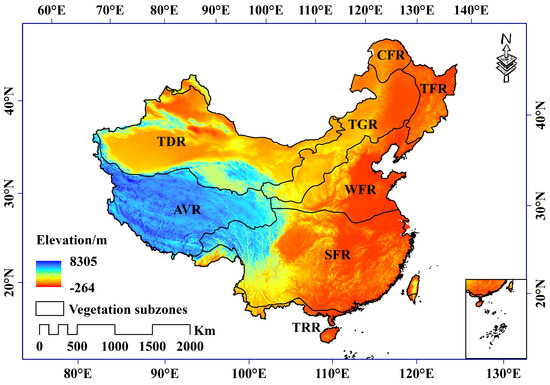
Figure 1.
The geographical location and elevations of China.
2.2. Dataset
2.2.1. Famine Early Warning Systems Network Land Data Assimilation System (FLDAS) Dataset
Drought-driving climatic variables were extracted from the Famine Early Warning Systems Network Land Data Assimilation System (FLDAS)—a global-coverage repository offering 0.10° spatial resolution and continuous temporal records since January 1982. This multivariate dataset integrates six critical parameters: air humidity (AH), air temperature (AT), evapotranspiration (ET), precipitation (PC), soil moisture (SM), and soil temperature (ST) [50].
2.2.2. Remote Sensing Datasets
The remote sensing datasets employed in this study include the Normalized Difference Vegetation Index (NDVI), potential evapotranspiration (ET0), and actual evapotranspiration (ETa). Detailed data sources and specifications are listed in Table 1. The NDVI data were obtained from the 8 km resolution AVHRR GIMMS NDVI monthly remote sensing dataset provided by the National Earth System Science Data Center. After preprocessing with ArcGIS software 10.7, these data effectively characterize vegetation growth status and density across the study area from 1982 to 2022 [29]. The ET0 data were sourced from the 1 km resolution monthly potential evapotranspiration dataset for China (1982–2022) released by the National Tibetan Plateau Data Center. Prior to analysis, the data were extracted using R software 4.3, converted to GeoTIFF format, and spatially clipped using ArcGIS. This dataset was generated using the Hargreaves equation based on monthly mean, minimum, and maximum temperature datasets at a 1 km resolution [51]. The ETa data were synthesized from global datasets provided by Harvard University (1982–2019) and the United States Geological Survey (2020–2022). Mosaicking, format conversion, and spatial clipping were performed to align these data with ET0 in terms of spatial resolution and units [52,53]. In addition, for missing values in FLDAS and NDVI data, a neighborhood statistical imputation method was employed, which involved spatial interpolation using the mean value of neighboring grid points to fill in the missing data [54].

Table 1.
Websites and information regarding the remote sensing datasets used in this study.
2.2.3. Standardized Precipitation Evapotranspiration Index (SPEI) Dataset
The Standardized Precipitation Evapotranspiration Index (SPEI) at a 5 km resolution (1982–2022), sourced from the Centre for Environmental Data Analysis, served as the meteorological drought metric [55]. To ensure spatial consistency across datasets, all data were preprocessed using bilinear interpolation and resampled to an 8 km resolution, with the study period set from 1982 to 2022.
2.3. Methodology
2.3.1. Construction of a Standardized Drought Index
Standardized drought indices offer distinct advantages in spatial comparability, probabilistic interpretability, and computational efficiency [12]. Specifically, the standardized ecological water deficit index (SEWDI) was developed through the following steps: The derivation of ecological water consumption (EWC) was initiated by computing latent heat flux through the Surface Energy Balance System (SEBS) model, operationalized via the Python 3.11 computational environment. Concurrently, the FAO-56 crop coefficient methodology was applied to determine the ecological water requirement (EWR), ensuring alignment with internationally standardized agricultural water budgeting protocols. Following the water balance paradigm, ecological water deficit (EWD) was computed from the disparity between EWC and EWR. Subsequent phases involved probability distribution optimization—statistical fitting of EWD series to identify optimal parametric models; frequency transformation—conversion of cumulative EWD distributions to standardized through inverse normalization, culminating in the SEWDI metric.
where NDVImax denotes the maximum NDVI under full vegetation coverage; ETa represents actual evapotranspiration; Kc is the crop coefficient for distinct growth stages; ET0 signifies potential evapotranspiration; EWC, EWR, and EWD correspond to ecological water consumption, ecological water requirement, and ecological water deficit, respectively; Fyi denotes the cumulative probability; and SEWDI quantifies drought severity inversely, with lower values indicating intensified drought conditions.
2.3.2. Bayesian Estimator of Abrupt Seasonal and Trend Change Algorithm (BEAST)
The BEAST algorithm, rooted in Bayesian statistical frameworks, probabilistically detects abrupt transitions in time series through offline change-point analysis [56]. Its methodological superiority stems from constructing hierarchical prior–posterior probability distributions, iteratively refined via Bayesian updating to quantify uncertainties in mutation detection—a critical advancement over deterministic approaches [57,58]. The algorithm decomposes temporal signals Yτ into three constituent elements:
where Tτ denotes the trend component; Sτ denotes the seasonal component; ε denotes the residual component. For a trend component Tτ with detected breakpoints τ1, …, τm, the piecewise linear model is expressed as
where i indexes the breakpoint location; αi and βi represent intercepts and slopes on either side of the breakpoint, respectively. The seasonal component Sτ is modeled via periodic functions:
where γk and δk denote amplitude and phase parameters, respectively; f represents frequency.
In this study, BEAST was applied to detect mutation points in SEWDI, enabling a comprehensive analysis of ecological drought dynamics. The algorithm classified evolutionary trends into eight distinct categories, encapsulating diverse drought progression patterns.
2.3.3. Improved Run Theory and Copula-Based Recurrence Period
As a multidimensional natural hazard, ecological drought can be quantified by core parameters such as drought duration and severity. This study developed a three-tier threshold identification system (X0 = 0, X1 = −0.3, X2 = −0.5) based on enhanced run theory to improve drought event detection accuracy. Drought duration is defined as the interval between initiation and termination, while severity is the cumulative absolute negative deviation of SEWDI during the event. To mitigate misjudgment issues from single-threshold methods [59,60], a refined identification protocol was implemented:
- (1)
- A preliminary drought is triggered when SEWDI falls below X1;
- (2)
- Single-month droughts with SEWDI above X2 are deemed invalid;
- (3)
- Adjacent droughts separated by one month (with intermediate SEWDI < X0) are merged, with aggregated duration and severity.
After extracting drought characteristics, a joint probability model was constructed using Copula functions to capture nonlinear dependencies between drought duration and severity. Five Copula families (Gaussian, t, Clayton, Frank, and Gumbel) were evaluated [61]. A multi-criteria optimization framework, which incorporated the root mean square error (RMSE), Akaike information criterion (AIC), and Bayesian information criterion (BIC), was employed to select the optimal Copula [62]. As shown in Table 2, the selected Copula was used to establish a joint probability distribution, enabling the derivation of return periods for diverse drought scenarios through inverse probability calculations.

Table 2.
Copula families used in this study.
2.3.4. Modified Mann–Kendall Method (MMK)
The MMK method, an enhanced nonparametric extension of the Mann–Kendall framework, addresses autocorrelation biases in hydrological and meteorological trend analysis. Unlike conventional trend tests that merely classify directional trends, the MMK framework incorporates spatial continuity constraints, enabling robust visualization of spatially coherent trend patterns while suppressing autocorrelation artifacts. This innovation improves significance testing fidelity without sacrificing statistical power, cementing its utility in geoscientific applications [63].
2.3.5. Cross-Wavelet Transform Technology
To elucidate the driving mechanisms of climatic factors on ecological drought dynamics (quantified by SEWDI), we employed advanced wavelet coherence techniques. Specifically, we aimed, first, to identify the primary univariate climate drivers and their scale-dependent effects on SEWDI while eliminating potential spurious correlations caused by confounding factors; second, to decipher the synergistic effects of multiple climate factors on SEWDI under multi-coupling conditions. These objectives were achieved using the following methods:
- (1)
- The PWC leverages wavelet-based time–frequency decomposition to isolate oscillatory components of time series across distinct spectral bands [64]. While traditional bivariate wavelet coherence identifies scale-specific interdependencies between variables, PWC eliminates spurious correlations induced by confounding factors through partial covariance conditioning [65]. This capability is particularly critical in drought studies where multiple drivers exhibit collinear behaviors.
- (2)
- Multiple wavelet coherence (MWC), a cornerstone analytical tool in geophysical research, investigates how a target variable depends on synergistic interactions among multiple predictors. By integrating cross-wavelet and auto-wavelet power spectra within a rigorous theoretical framework, MWC enables precise quantification of complex synergistic dependencies, thereby advancing mechanistic understanding of geophysical systems. During wavelet analysis, the percentage of significant power (POSP) and average wavelet coherence (AWC) are computed to quantitatively assess the explanatory capacity of predictor variables on the response variable [66].
3. Results
3.1. Characterizing the Multi-Scale Temporal Evolution of Ecological Drought
Figure 2 illustrates the monthly variations of SEWDI across mainland China and its vegetation sub-regions from 1982 to 2022. The results reveal a significant decreasing trend in SEWDI at the national scale (linear trend rate: −0.013/10a), with the lowest value of −1.21 recorded in February 2020, indicating peak ecological drought stress during this period. Regional comparisons demonstrate marked disparities in both trend magnitude and extreme values among vegetation sub-regions. AVR exhibited the most rapid decline (–0.033/10a), reaching its minimum SEWDI value of −1.78 in March 2022. Although CFR had the lowest mean SEWDI (−0.032), its most extreme drought event occurred in November 2021 (SEWDI = −2.43). Notably, the timing of SEWDI minima varied substantially across regions, reflecting spatial asynchrony in ecological drought occurrence. These findings collectively indicate an overall intensification of ecological drought across China from 1982 to 2022, with coexisting homogeneity in drought intensification and heterogeneity in spatiotemporal patterns among vegetation zones.
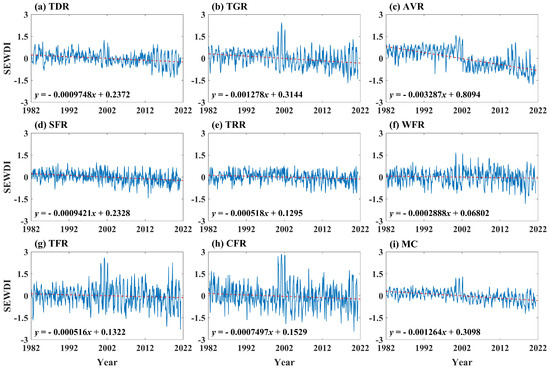
Figure 2.
Monthly variations of SEWDI during 1982–2022 across regions: (a) TDR, (b) TGR, (c) AVR, (d) SFR, (e) TRR, (f) WFR, (g) TFR, (h) CFR, and (i) MC.
Figure 3 delineates the spatiotemporal heterogeneity of SEWDI across China at the decadal scale. During the study period, SEWDI exhibited an overall declining trend but with phased fluctuations: the 1980s marked the only upward phase (mean: 0.12), followed by continuous declines in subsequent decades (1990s: 0.11; 2000s: −0.14; 2010s: −0.04). Spatially, drought hotspot areas shifted significantly across decades. In the 1980s, low-value zones concentrated in TGR and TFR, while high-value zones dominated AVR and CFR. By the 2010s, low-value zones migrated to AVR and TRR, whereas high-value zones transitioned to WFR and TFR. Notably, AVR and CFR experienced accelerated ecological drought deterioration, with their mean SEWDI decreasing from 0.52 to −0.42 (Δ = −0.94) and 0.53 to −0.15 (Δ = −0.68), respectively, underscoring escalating ecological vulnerability. In contrast, TFR showed mitigation, with its mean SEWDI rising from −0.21 in the 1980s to 0.22 in the 2010s (Δ = +0.43). These results highlight both the overarching consistency and pronounced regional asynchrony in the spatiotemporal evolution of ecological drought across China.
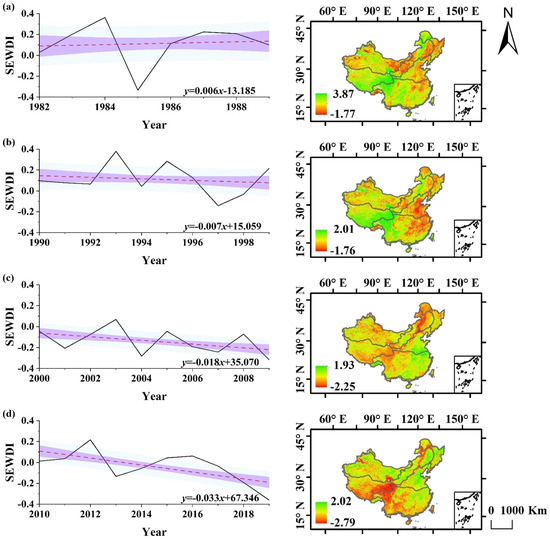
Figure 3.
Decadal-scale spatiotemporal patterns of SEWDI across China: (a) 1980s, (b) 1990s, (c) 2000s, and (d) 2010s.
The pronounced deterioration of ecological drought in AVR (trend rate: −0.033/10a; ΔSEWDI: −0.94 from the 1980s to 2010s) likely stems from amplified warming rates over the Tibetan Plateau compared to the national average [37], accelerating evapotranspiration and shortening snow cover duration, thus reducing water availability during critical growth periods. This aligns with Lei et al., who identified AVR as highly vulnerable, but our quantification of the trend magnitude and decadal shift provides finer spatiotemporal resolution [44].
Figure 4 employs the BEAST algorithm to dissect the temporal dynamics of SEWDI in China, with decomposed seasonal, trend, and residual components elucidating multi-scale drought evolution. The gray-shaded areas denote 95% confidence intervals around critical transition points and seasonal fluctuations. The seasonal component displayed periodic peaks from winter to spring, modulated by ecological phenology. The trend component revealed a drought alleviation phase from 1982 to 2002, followed by persistent intensification post-2003, suggesting potential threshold crossings in ecosystem stability triggered by climatic shifts or anthropogenic activities. Mutation detection identified a high-probability seasonal abrupt change in January 2003 (probability: 99.42%; confidence interval: December 2002–April 2003), during which the mean SEWDI plummeted from 1.29 to −0.22, signifying a systemic shift in ecological water supply–demand equilibrium. The trend component exhibited dual mutation points: January 2003 (probability: 96.35%; confidence interval: December 2002–December 2003) and November 2017 (probability: 43.67%; confidence interval: December 2013–October 2018), corresponding to drought intensification transitions and modern extreme climate episodes, respectively. The 59-month confidence interval span for the 2017 mutation point underscores heightened uncertainties in climate–ecosystem interactions during this period. These results validate the BEAST algorithm’s efficacy in probabilistically quantifying nonlinear drought mutation mechanisms.
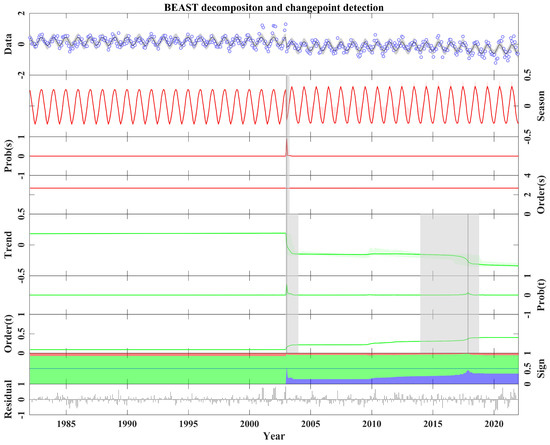
Figure 4.
Seasonal, trend, and residual components of SEWDI based on the BEAST algorithm in China during 1982–2022. The shaded area represents uncertainty, accompanied by the most likely mutation point corresponding to the maximum probability.
3.2. Dynamic Variation and Recurrence Period of Typical Drought Events
Using improved run theory, the drought event spanning September 2019 to April 2020 was identified as the most severe and extensive typical event during the study period, with a drought duration of 8 months and a severity of 6.28 (Figure 5). The drought signal emerged in September 2019, escalated into an outbreak phase by February 2020 (SEWDI = −1.21), and affected 83.61% of the total area. By April 2020, the drought core had contracted northeastward, yet 73.20% of the area remained water-stressed. Notably, WFR and TGR were the epicenters of drought stress, while AVR exhibited localized buffering effects due to glacial meltwater recharge.

Figure 5.
Spatiotemporal dynamics of the typical drought event (September 2019–April 2020) across China (1982–2022).
The concentration of stress in WFR and TGR may be linked to below-average precipitation combined with high temperatures during this period, consistent with patterns reported by Wang et al. for recurrent spring–summer droughts in subtropical zones [43]. The glacial meltwater buffering effect observed in parts of AVR highlights the critical role of cryosphere resources in mitigating drought impacts in high-altitude regions, a factor less emphasized in previous national-scale assessments [67].
Figure 6 presents the joint distributions of the drought duration–severity–return period for ecological drought events across China’s vegetation sub-regions, modeled using Copula functions. The results show that optimal Copula types and drought parameters varied regionally. Gaussian-Copula best captured the dependency structure in TDR, AVR, SFR, and WFR. Of these, 26 drought events were identified in the AVR region, including two extreme events that lasted up to 22 months: The June 2006 to March 2008 event had an intensity of 11.93 (return period of 12.43 years), and the July 2018 to April 2020 event had a region-wide peak of 19.09 (return period > 25 years). TDR, SFR, and WFR identified 30, 34, and 45 events, respectively, each with >10-year return period events (severity: 6.78, 5.43, 6.39, respectively).
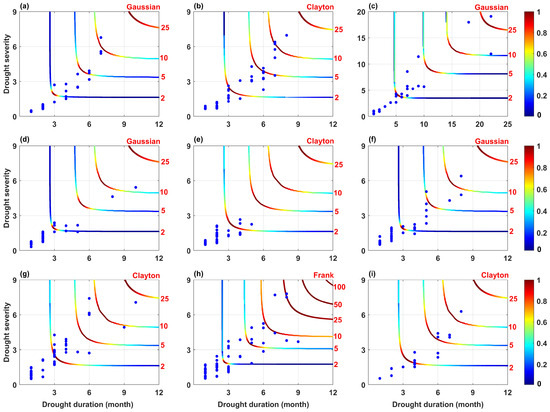
Figure 6.
The drought duration–severity–return period contour in different regions: (a) TDR, (b) TGR, (c) AVR, (d) SFR, (e) TRR, (f) WFR, (g) TFR, (h) CFR, and (i) MC. Blue dots denote individual drought events; contour colors represent probability densities (red: higher; blue: lower).
For TGR, TRR, and TFR, Clayton-Copula effectively modeled asymmetric tail dependencies. There were 38, 38, and 51 drought events in these three sub-regions, respectively, with a return period from one in 10 to one in 25 years, except in TRR (return period < 5 years). Notably, TFR, the region with the most frequent drought events, had a maximum return period of 22.62 years, reflecting ecosystem fragility. CFR modeled through Frank-Copula accumulated 66 events, although 63 with <10-year return periods, and two 8-month droughts (June 2004–January 2005 and June 2007–January 2008) reached 25-year levels (severity: 7.80 and 7.51, respectively). In MC, the 2019–2020 event (duration: 8 months; severity: 6.29) exceeded a 10-year return period under Clayton-Copula. Nationally, drought duration and severity correlated positively with the return period, yet 95% of events had <10-year return periods, indicating high-frequency, low-intensity dominance.
3.3. Spatial Trend Distribution of Ecological Drought at the Pixel Scale
Figure 7 illustrates the spatial variation trends of SEWDI across terrestrial China from 1982 to 2022, while Figure 8 quantifies the spatiotemporal differences in Zs of SEWDI among vegetation sub-regions. Zs > 0 indicate a gradual alleviation of drought conditions, while Zs < 0 signifies intensification of drought severity. On a monthly scale, the averaged Zs values of SEWDI across all pixels in terrestrial China from January to December were −1.02, −0.83, −0.56, −0.53, 0.15, 0.30, 0.04, −0.02, −0.25, −0.78, −0.84, and −0.90, respectively. The Zs mean value of −0.44 (<0) reveals an overall declining trend in SEWDI from 1982 to 2020. Specifically, Zs remained negative from January to April, reaching its minimum (−1.02) in January, indicating severe drought stress from winter to early spring. A shift to positive Zs values occurred from May to July, peaking at 0.30 in June, which reflects mitigated water supply–demand conflicts during the summer vegetation growing season. From August to December, Zs values declined again, with December (−0.90) marking the resurgence of drought in autumn and winter. Among all vegetation sub-regions, AVR exhibited the most pronounced decline in SEWDI, with the lowest annual Zs mean of −1.11. Notably, Zs values across all sub-regions were negative in January, signifying a synchronous decline in SEWDI nationwide during this month.
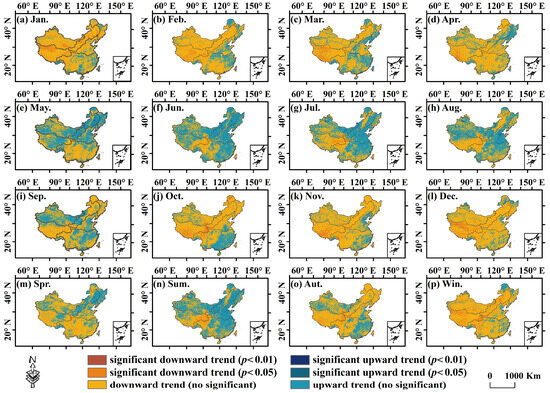
Figure 7.
Trend characteristics of SEWDI based on the spatial trend identification.
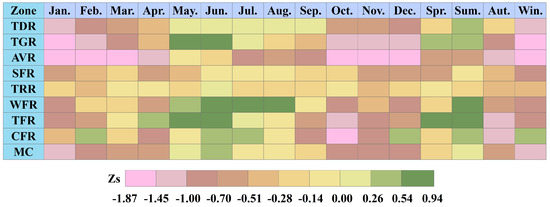
Figure 8.
The average Zs values in various regions of China during 1982–2022.
Seasonal analysis shows that Zs means for SEWDI in spring (−0.22), autumn (−0.60), and winter (−1.06) exhibited declining trends, with only summer (0.19) showing slight alleviation. The quarterly Zs mean of −0.42 (<0) confirms an overall intensification of ecological drought at the seasonal scale. Except for summer, SEWDI declined across all seasons, with the most significant deterioration observed in winter (Zs = −1.06). Among all sub-regions, regional disparities in drought trends were evident, with AVR displaying the lowest quarterly Zs mean (−1.09), underscoring its ecological vulnerability. Remarkably, negative Zs values in all sub-regions during winter highlight the widespread synchronicity of ecological drought in cold seasons. In summary, monthly and seasonal analyses demonstrate that Zs values were predominantly negative across most regions of China from 1982 to 2022, indicating a widespread decline in SEWDI and intensification of ecological drought. Furthermore, gridded ecological drought trends exhibited substantial spatiotemporal heterogeneity. AVR experienced the most severe aggravation, with monthly and seasonal Zs means of −1.11 and −1.09, respectively. January emerged as a pan-regional drought month, while winter represented a seasonally synchronized drought period.
As depicted in Figure 9, the areal percentage of ecological drought intensification from 1982 to 2020 ranged from 35.63% (June) to 88.51% (January) on a monthly scale. The monthly sequence (January–December) was 88.51%, 81.60%, 75.44%, 76.87%, 45.45%, 35.63%, 46.42%, 49.41%, 62.44%, 78.64%, 84.40%, and 86.92%. Notably, 1.60% and 7.88% of the area in January exhibited statistically significant intensification at the 0.01 and 0.05 levels, respectively. In June, only 0.28% (p < 0.01) and 0.57% (p < 0.05) of the area showed significant drought aggravation. Seasonally, the areal percentages of drought intensification were 63.05% (spring), 41.01% (summer), 74.04% (autumn), and 87.01% (winter). In winter, 2.04% and 7.72% of the area showed significant trends at the 0.01 and 0.05 levels, respectively, while 77.24% of the area displayed non-significant intensification. Overall, the spatiotemporal evolution of ecological drought in China during the study period was characterized by pronounced intensification, with the highest areal percentages of aggravation observed in January (88.51%) and winter (87.00%).
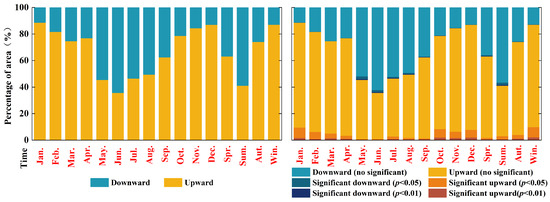
Figure 9.
The percentage of the trend area of ecological drought changes (increasing or decreasing) in different months and seasons.
3.4. Identification of Driving Factors
3.4.1. Univariate Influencing Factors
As shown in Figure 10, PWC analysis was conducted to eliminate confounding variables. Rightward arrows indicate positive phase relationships, while leftward arrows denote negative phase relationships. Color bands represent wavelet coherence coefficients, with bold contours marking regions exceeding the 95% confidence level. The time–frequency domain was partitioned into three scales: small (<8 months), medium (8–32 months), and large (>32 months). SEWDI exhibited complex coherence with climatic factors at the small and medium scales, characterized by fluctuating phase angles. In contrast, phase relationships stabilized and became more distinct at the large scale.
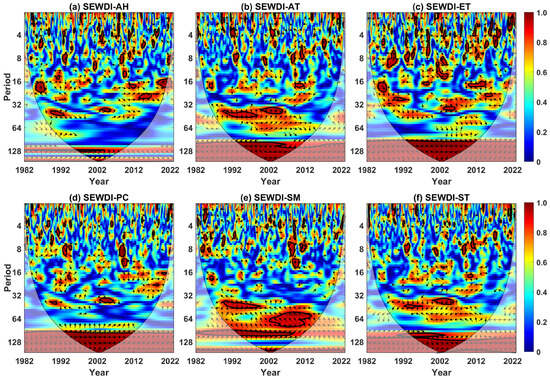
Figure 10.
The partial wavelet coherence between SEWDI and climate-related factors (AH, AT, ET, PC, SM, and ST). The color bands represent wavelet coherence coefficients.
After removing the effects of AH, AT, PC, SM, and ST, the high-energy coherence between SEWDI and ET was concentrated at the large scale (>32 months), predominantly exhibiting negative phase relationships across scales. At the small scale, SEWDI and ET displayed intermittent resonance cycles (AWC = 0.91, POSP = 8.30%; Table 3). Medium-scale analysis identified five resonance periods: 16–24 months (1985–1987), 8–11 months (1987–1990), 27–30 months (1989–1993), 9–15 months (2000–2004), and 16–19 months (2009–2014), with AWC and POSP values of 0.90% and 6.11%, respectively. Two prominent resonance cycles were observed at the large scale: 35–41 months (2002–2005) and 102–170 months (1993–2011), yielding AWC = 0.96 and POSP = 37.21%. Additionally, partial coherence between SEWDI and AT revealed inconsistent phase relationships across time and frequency domains. At the smaller scale, the resonance between SEWDI and AH was weaker, with coherent signals primarily confined to interannual-to-decadal intervals. Similarly, the PWC of SEWDI with other climate factors is shown in Figure 10.

Table 3.
The AWC and POSP values between SEWDI and climate factors (AH, AT, ET, PC, SM, and ST) at different time–frequency scales (small, medium, and large).
To summarize, ET dominated SEWDI variability at the small (POSP = 8.30%) and medium (6.11%) scales, whereas PC exerted a stronger influence at the large scale (POSP = 37.53%). At all time–frequency scales, ET achieved the highest cumulative POSP (18.75%; Table 3), establishing it as the optimal univariate driver of ecological drought dynamics in China.
3.4.2. Multivariate Influencing Factors
Univariate drivers inadequately capture the multi-scale complexity of ecological drought. MWC offers a novel perspective to unravel synergistic effects among climatic factors. As illustrated in Figure 11, MWC elucidates how combined drivers shape multi-scale drought characteristics. Critically, interactions between climatic factors are pivotal in explaining the spatiotemporal heterogeneity of ecological drought. The ET–SM combination exhibited the highest bivariate POSP (19.05%), indicating their co-dominant role in driving ecological drought dynamics. At the small scale, ET–SM and SEWDI showed intermittent resonance cycles, while the medium scale featured two primary cycles: 8–18 months (1983–2001) and 8–32 months (2004–2021). Large-scale analysis identified three resonance cycles: 96–105 months (2001–2004), 50–66 months (2002–2015), and 40–44 months (2015–2017), underscoring the robust explanatory power of ET–SM interactions.
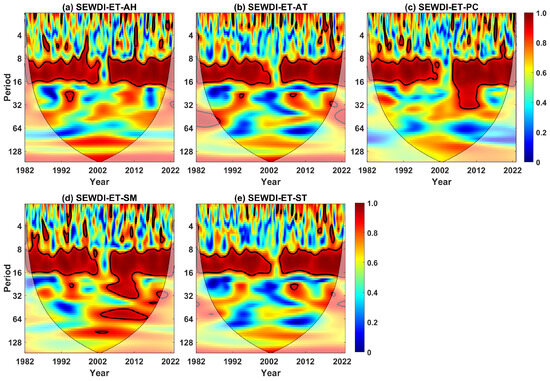
Figure 11.
The multivariable-based wavelet coherence between ET and other climate factors (PC, SM, AH, ST, and AT). The color bands represent wavelet coherence coefficients.
Figure 12 demonstrates enhanced explanatory capacity under trivariate coupling. The ET–SM–AH combination emerged as the optimal trivariate driver (AWC = 0.97, POSP = 19.21%; Table 4). Medium-scale trivariate coherence revealed three cycles: 8–18 months (1983–2003), 8–32 months (2005–2022), and 23–30 months (1984–1988). The large scale featured two cycles: 52–59 months (2006–2010) and 32–37 months (2008–2012). Post-2005, the strengthened coherence between ET–SM–AH and SEWDI reflects intensified climatic impacts since the 21st century. With the highest POSP (19.21%), ET–SM–AH represents the optimal trivariate combination for explaining ecological drought dynamics. The dominance of ET across scales confirms its role as the primary conduit for water loss from ecosystems under drought stress [68]. The stronger influence of PC at the large scale highlights the fundamental role of precipitation deficits in driving long-term drought persistence. Our finding that the synergistic effect of ET–SM–AH (POSP = 19.21%) surpasses univariate ET dominance aligns with the conceptual understanding that ecological drought arises from the imbalance between atmospheric demand, soil water supply, and vegetation water use but provides novel quantitative evidence of their coupled influence at multiple timescales [12]. This multivariate perspective offers a more mechanistic explanation than traditional single-factor analyses [47].
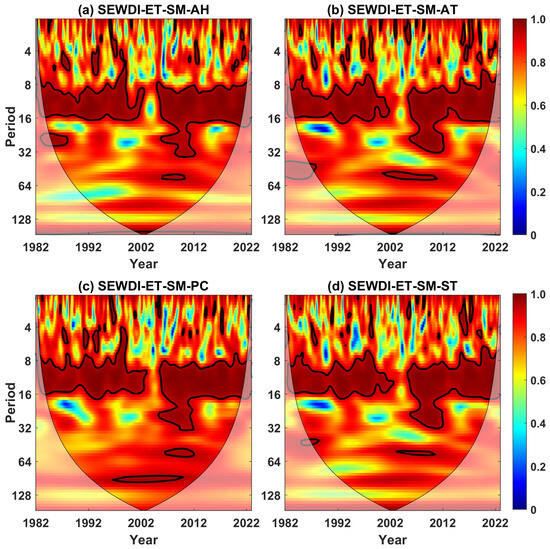
Figure 12.
The multivariable-based wavelet coherence between ET–SM and other climate factors (PC, AH, ST, and AT). The color bands represent wavelet coherence coefficients.

Table 4.
The AWC and POSP values between SEWDI and climate factors (PC, AT, ST, AH, SM, and ET) based on MWC.
4. Discussion
4.1. Discussion of Ecological Drought Response to Meteorological Drought
The self-regulatory capacity of ecosystems may lead to temporal asynchrony between meteorological drought events and ecological water deficits. We categorized the meteorological drought events that caused ecological water deficits (Type 1) and those that did not (Type 2), and calculated their drought duration, severity, and severity peaks (Figure 13). For Type 1 events, the mean drought duration was 2.07 months, significantly longer than that of Type 2 events (1.53 months). The longest drought duration (11 months) for Type 1 occurred from June 2007 to April 2008. Similarly, the mean severity values for Type 1 and Type 2 were 1.46 and 0.99, respectively. The maximum severity peak of Type 1 exceeded that of Type 2 by 31.46%. These results collectively indicate that severe meteorological droughts (Type 1) are more likely to trigger ecosystem water supply–demand imbalances due to their prolonged duration, higher severity, and intensified peaks.

Figure 13.
Comparison of violin diagrams for different types of meteorological drought events. (a), (b), and (c) denote the drought duration, severity, and peak values, respectively.
Furthermore, meteorological drought impacts on ecological drought exhibited lagged and cumulative effects, with heterogeneous responses across vegetation sub-regions (Figure 14). The maximum correlation coefficient between SEWDI and SPEI reflects the intensity of meteorological drought’s influence, while the lag time indicates the sensitivity of ecological drought responses, where a shorter lag time suggests higher sensitivity. Across mainland China (1982–2022), the maximum correlation coefficient ranged from –0.38 to 0.99 (mean: 0.48), indicating a significant positive correlation. Regions with strong positive correlations were concentrated in TDR, TGR, TFR, and CFR, with mean coefficients of 0.51, 0.54, 0.59, and 0.62, respectively. Lag time analysis revealed pronounced regional disparities, with an overall mean of 5.32 months. Notably, TFR and CFR exhibited the fastest responses (1–3 months), whereas the other sub-regions showed delayed responses (4–6 months).
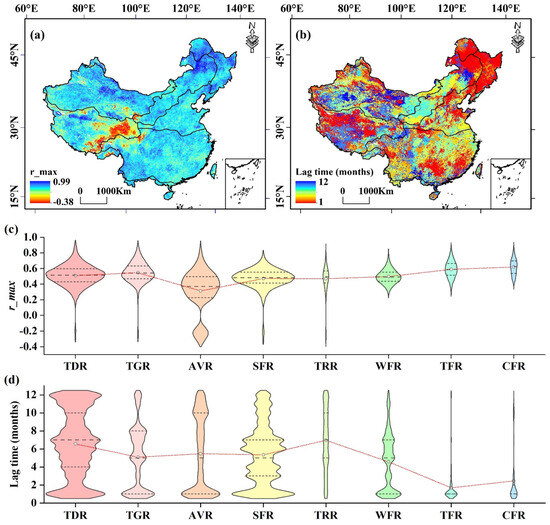
Figure 14.
The response of ecological drought to meteorological drought in various sub-zones of China. (a,c) The maximum correlation coefficient between SEWDI and SPEI. (b,d) The lag time between ecological drought and meteorological drought.
Intriguingly, a weak negative correlation between SEWDI and SPEI was observed in eastern AVR (Figure 14), contrasting with conventional drought propagation theories. This anomaly likely stems from spatial heterogeneity in vegetation adaptation strategies and hydrological regulation specific to this high-altitude environment [69]. For instance, alpine vegetation in eastern AVR maintains water use efficiency during mild meteorological droughts through stomatal conductance modulation and osmotic adjustment, reducing the linkage between ecological drought severity and meteorological intensification [16]. Additionally, the gradual thawing of permafrost in warm seasons creates a “slow-release reservoir” effect, buffering short-term precipitation deficits via sustained soil moisture replenishment [70]. While factors such as soil water-holding capacity, vegetation type, and topography are widely recognized modulators of drought propagation lag times and response intensities, the atypical response pattern observed in eastern AVR is primarily dominated by a unique combination of specialized vegetation adaptations and cryosphere hydrology. This distinctive mechanism underscores the necessity of integrating multi-process coupled models for ecological drought assessment in complex terrains [71,72,73].
4.2. Reasons for the Results and Comparison with Previous Literature
In this study, the BEAST algorithm detected a critical seasonal mutation point: January 2003 (probability 99.42%). The 2003 mutation closely aligns with accelerated climate warming and frequent extreme events in China and globally, potentially marking a threshold response of ecosystem water balance to sustained warming [41,74]. Secondly, the mutation may relate to the strong El Niño event and its cascading effects, or regional anthropogenic activities [7,40]. Identifying these mutation points is crucial for understanding ecosystem responsiveness to climatic shifts and establishing ecological restoration baselines. In management practice, post-mutation periods should be designated as phases of heightened vigilance requiring intensified monitoring and elevated warning levels.
In addition, MWC analysis revealed that the synergistic effect of ET–SM–AH (POSP = 19.21%) constitutes the optimal combination for explaining ecological drought dynamics (Table 4). The underlying mechanism lies in the nonlinear regulation of ecosystem water balance through multiple processes: ET dominates water consumption (demand side), SM represents soil reservoir status (supply side), while AH modulates vegetation transpiration and soil evaporation rates by influencing the vapor pressure deficit [46,75]. The coupling of these three factors amplifies water deficit effects: High ET (strong evapotranspiration) combined with low SM (insufficient soil water storage) directly disrupts water supply–demand equilibrium. Low AH (dry air) further increases atmospheric evaporative demand, intensifying vegetation water extraction pressure from soil, particularly during growing seasons or drought periods. This finding demonstrates that drought monitoring indices focusing solely on single factors may severely underestimate actual vegetation water stress [47].
Through comparative analysis with previous literature, this study reveals that the spatiotemporal heterogeneity of terrestrial ecological drought in China is consistent with previous research findings. Furthermore, it advances our understanding of the mechanisms of ecological drought through a new analytical framework. Wan et al. demonstrated significant spatial divergence in drought hotspot expansion and intensification across China using high-resolution SPEI data, with accelerated drought escalation in northeastern and northern regions compared to humid southern areas [74]. This echoes our observation of distinct ecological drought characteristics among vegetation sub-regions, jointly highlighting the heightened sensitivity of ecologically fragile zones. Jiang et al. further reported escalating spatial extent, duration, and severity of ecological drought events in China since the 21st century, alongside a westward migration of drought cores [68]. These findings strongly corroborate our results, particularly the intensified drought in AVR, where the mean SEWDI declined by 0.94 from the 1980s to the 2010s, and the prolonged return periods, as seen in the 2018–2020 event, which exceeded 25 years. Regarding driving factors, Shang et al. emphasized ET as a pivotal process in land–atmosphere hydrothermal exchange, effectively capturing moisture stress in arid/semiarid ecosystems [75]. This supports our identification of ET as the dominant univariate driver (POSP = 18.75%). In previous studies on drought drivers, most scholars have tended to focus on a single climate factor (such as precipitation or evaporation), which has prevented them from analyzing the nonlinear interactions between multiple climate factors [12]. However, unlike prior studies, our MWC analysis revealed that the bivariate coupling of ET and SM (POSP = 19.05%) explained ecological drought dynamics more effectively than individual variables. ET–SM–AH exhibited stronger synergies and further enhanced the explanatory power of the drought (POSP = 19.21%). The combined application of PWC and MWC provides a new perspective for analyzing multi-factor nonlinear interactions [76].
4.3. Practical Significance and Impact of the Research Results
The findings of this study offer concrete scientific support for enhancing drought early warning systems and developing spatially targeted adaptation strategies across China:
- (1)
- Refined Drought Monitoring and Early Warning: The SEWDI index, grounded in vegetation water supply–demand equilibrium, provides a direct measure of ecological water stress [12]. Its integration into national and regional drought monitoring platforms can significantly improve the detection of incipient and ecologically significant drought conditions, particularly during critical periods like winter and early spring, as identified here. The probabilistic detection of abrupt changes using BEAST offers a novel tool for identifying potential regime shifts in ecosystem drought susceptibility, serving as critical triggers for escalating drought response levels [57,58].
- (2)
- Regionalized Risk Assessment and Prioritization: The pronounced spatial heterogeneity in drought intensification trends (severe in AVR, milder in TFR), peak drought months (January nationally), and dominant drivers (ET–SM–AH synergy) underscores the necessity of regionalized drought risk management. Regions like AVR, exhibiting the most rapid deterioration and hosting fragile alpine ecosystems, require prioritized monitoring resources and proactive adaptation investments [16,72]. Maps of gridded trend eigenvalues (Zs; Figure 7) and drought hotspot shifts (Figure 3) can directly inform spatial planning for drought resilience.
- (3)
- Validating and Improving Predictive Models: The scale-dependent drivers identified by PWC-MWC (ET dominance at short scales, PC at long scales, ET–SM–AH synergy) provide critical empirical constraints for parameterizing and improving dynamical vegetation and drought prediction models. Incorporating these multivariate, scale-aware relationships can enhance the accuracy of forecasts, particularly for anticipating the ecological impacts of meteorological droughts with known lag times [37,43].
In summary, moving beyond traditional meteorological drought assessment, this study provides the scientific basis for an ecologically integrated drought management framework in China. By leveraging SEWDI for monitoring, understanding regional vulnerabilities and key drivers, and utilizing advanced methods for change detection and driver attribution, policymakers and land managers can make more informed decisions to enhance ecosystem resilience and water security in the face of increasing drought risks.
5. Conclusions
This study systematically investigated ecological drought in China from 1982 to 2022 by constructing SEWDI using FLDAS and remote sensing datasets. Advanced analytical methods were integrated to identify seasonal, abrupt, and trend characteristics of ecological drought, analyze the spatial distribution of typical drought events and joint return periods of drought variables, delineate gridded drought dynamics, and elucidate the coupled driving effects of multiple influencing factors. The main conclusions are summarized as follows:
- (1)
- From 1982 to 2022, SEWDI across mainland China exhibited an overall declining trend, reaching its minimum value of −1.21 in February 2020. Among all vegetation sub-regions, AVR showed the most pronounced decrease (linear trend rate: −0.032/10a), with a minimum SEWDI of −1.78 in March 2022. At the decadal scale, SEWDI displayed an upward trend in the 1980s but shifted to a continuous decline from the 1990s onward. Notably, the average value of SEWDI in AVR decreased from 0.52 in the 1980s to −0.42 in the 2010s.
- (2)
- The seasonal component of SEWDI derived from the BEAST algorithm exhibited periodic fluctuations, peaking in winter and spring. A seasonal abrupt change was detected in January 2003, with a probability of 99.42%, during which the average value of SEWDI dropped from 1.29 to 0.10. The trend component transitioned from an increasing phase (1982–2002) to a decreasing phase (2002–2022), with two mutation points identified in January 2003 (probability: 96.35%) and November 2017 (probability: 43.67%).
- (3)
- The most severe ecological drought event in mainland China (MC) occurred from September 2019 to April 2020, with a maximum severity of 6.28. The optimal Copula functions for characterizing drought duration–severity–return period relationships varied across vegetation sub-regions. The Clayton-Copula was identified as the optimal model for MC, yielding a mean drought duration of 4.32 months, a mean severity of 2.46, and a return period exceeding 10 years.
- (4)
- Spatially heterogeneous trends in ecological drought were observed at the grid scale. On a monthly scale, the mean Zs of SEWDI reached its lowest values in January (–1.02) and December (−0.90), with partial alleviation from May to July. Seasonally, the mean Zs ranged from −1.06 (winter) to 0.19 (summer), indicating pronounced drought intensification in winter. The highest proportions of drought-aggravated areas occurred in January (88.51%) and winter (87.01%). Notably, AVR exhibited the most severe annual drought intensification, with a mean Zs of −1.11.
- (5)
- Under univariate driving factors, ET exerted the strongest influence on SEWDI (AWC = 0.95, POSP = 18.75%), predominantly exhibiting negative phase relationships across scales. For multivariate interactions, the bivariate ET–SM combination dominated drought dynamics, while the trivariate ET–SM–AH synergy emerged as the optimal driver (POSP = 19.21%), with enhanced explanatory power since the 21st century.
- (6)
- The response of ecological drought to meteorological drought demonstrated that the maximum correlation coefficient between SEWDI and SPEI exhibited a mean value of 0.48. However, a weak negative correlation was observed in eastern AVR, attributed to alpine vegetation’s osmotic regulation and the permafrost “slow-release reservoir” effect. Lag time analysis highlighted regional disparities: Faster responses occurred in TFR and CFR (1–3 months), whereas other sub-regions exhibited delayed responses (4–6 months), reflecting spatial heterogeneity in ecosystem drought resilience.
In summary, the research findings not only deepen our theoretical understanding of the complex processes of ecological drought but, more importantly, they provide a key scientific basis and practical tools for constructing a precise ecological drought monitoring and early warning system and formulating spatially adapted drought adaptation strategies based on ecosystem vulnerability differentiation and dominant driving mechanisms (such as enhanced monitoring of key areas/periods, protection of natural buffer functions, risk management based on return periods, and precise water resource allocation). This has important practical value for enhancing the resilience and sustainable management of China’s terrestrial ecosystems in response to climate change.
Author Contributions
Conceptualization, Q.Q. and Y.L.; methodology, M.D. and W.Y.; original draft preparation, R.M. and F.W.; validation, K.F. and S.H.; software, H.L.; funding acquisition, F.W. and H.Y. All authors have read and agreed to the published version of the manuscript.
Funding
This research was supported by the National Natural Science Foundation of China (grant number 42401022), the National Key R&D Program of China (grant number 2023YFC3006603), the Innovation Fund for doctoral of North China University of Water Resources and Electric Power (grant number BCJJ202404), the Open Research Fund of the Key Laboratory of River Basin Digital Twinning of Ministry of Water Resources (grant number Z0202042022), Key Research Projects of Higher Education Institutions in Henan Province (grant number 24A570005), and Scientific and Technological Research Projects in Henan Province (grant number 242102321005).
Data Availability Statement
Data can be requested from the corresponding author upon reasonable request.
Acknowledgments
Thanks for the help with language editing provided by Yingying Wang.
Conflicts of Interest
The authors declare that the research was conducted in the absence of any commercial or financial relationships that could be construed as a potential conflict of interest. The authors declare that this study received funding from the National Natural Science Foundation of China (grant number 42401022). The funder was not involved in the study design; the collection, analysis, and interpretation of data; the writing of this article, or the decision to submit it for publication.
References
- Mishra, A.K.; Singh, V.P. A review of drought concepts. J. Hydrol. 2010, 391, 202–216. [Google Scholar] [CrossRef]
- Crausbay, S.D.; Betancourt, J.; Bradford, J.; Cartwright, J.; Dennison, W.C.; Dunham, J.; Enquist, C.A.; Frazier, A.G.; Hall, K.R.; Littell, J.S.; et al. Unfamiliar territory: Emerging themes for ecological drought research and management. One Earth 2020, 3, 337–353. [Google Scholar] [CrossRef]
- Zhou, Z.Q.; Shi, H.Y.; Fu, Q.; Li, T.X.; Gan, T.Y.; Liu, S.N.; Liu, K. Is the cold region in Northeast China still getting warmer under climate change impact? Atmos. Res. 2020, 237, 104864. [Google Scholar] [CrossRef]
- Sadiqi, S.S.J.; Hong, E.M.; Nam, W.H.; Kim, T. Review: An integrated framework for understanding ecological drought and drought resistance. Sci. Total Environ. 2022, 846, 157477. [Google Scholar] [CrossRef] [PubMed]
- Fang, W.; Huang, S.Z.; Huang, Q.; Huang, G.H.; Wang, H.; Leng, G.Y.; Wang, L.; Li, P.; Ma, L. Bivariate probabilistic quantification of drought impacts on terrestrial vegetation dynamics in mainland China. J. Hydrol. 2019, 577, 123980. [Google Scholar] [CrossRef]
- Forootan, E.; Khaki, M.; Schumacher, M.; Wulfmeyer, V.; Mehrnegar, N.; van Dijk, A.I.; Brocca, L.; Farzaneh, S.; Akinluyi, F.; Ramillien, G.; et al. Understanding the global hydrological droughts of 2003–2016 and their relationships with teleconnections. Sci. Total Environ. 2019, 650, 2587–2604. [Google Scholar] [CrossRef] [PubMed]
- Manzano, A.; Clemente, M.A.; Morata, A.; Luna, M.Y.; Beguería, S.; Vicente-Serrano, S.M.; Martín, M.L. Analysis of the atmospheric circulation pattern effects over SPEI drought index in Spain. Atmos. Res. 2019, 230, 104630. [Google Scholar] [CrossRef]
- Yao, Y.; Fu, B.J.; Liu, Y.X.; Li, Y.; Wang, S.; Zhan, T.; Wang, Y.; Gao, D. Evaluation of ecosystem resilience to drought based on drought intensity and recovery time. Agric. For. Meteorol. 2022, 314, 108809. [Google Scholar] [CrossRef]
- Su, X.L.; Jiang, T.L.; Niu, J.P. Concept and review of ecological drought. Water Resour. Prot. 2021, 37, 15–21. [Google Scholar]
- Crausbay, S.D.; Ramirez, A.R.; Carter, S.L.; Cross, M.S.; Hall, K.R.; Bathke, D.J.; Betancourt, J.L.; Colt, S.; Cravens, A.E.; Dalton, M.S.; et al. Defining ecological drought for the twenty-first century. Bull. Am. Meteorol. Soc. 2017, 98, 2543–2550. [Google Scholar] [CrossRef]
- Munson, S.M.; Bradford, J.B.; Hultine, K.R. An Integrative Ecological Drought Framework to Span Plant Stress to Ecosystem Transformation. Ecosystems 2021, 24, 739–754. [Google Scholar] [CrossRef]
- Jiang, T.L.; Su, X.L.; Singh, V.P.; Zhang, G.X. A novel index for ecological drought monitoring based on ecological water deficit. Ecol. Indic. 2021, 129, 107804. [Google Scholar] [CrossRef]
- Huang, W.J.; Wang, W.; Cao, M.; Fu, G.; Xia, J.; Wang, Z.; Li, J. Local climate and biodiversity affect the stability of China’s grasslands in response to drought. Sci. Total Environ. 2021, 768, 145482. [Google Scholar] [CrossRef] [PubMed]
- Dai, M.; Huang, S.; Huang, Q.; Zheng, X.; Su, X.; Leng, G.; Li, Z.; Guo, Y.; Fang, W.; Liu, Y. Propagation characteristics and mechanism from meteorological to agricultural drought in various seasons. J. Hydrol. 2022, 610, 127897. [Google Scholar] [CrossRef]
- Sungmin, O.; Park, S.K. Global ecosystem responses to flash droughts are modulated by background climate and vegetation conditions. Commun. Earth Environ. 2024, 5, 88. [Google Scholar] [CrossRef]
- Lin, H.; Yu, Z.; Chen, X.; Gu, H.; Ju, Q.; Shen, T. Spatial-temporal dynamics of meteorological and soil moisture drought on the Tibetan Plateau: Trend, response, and propagation process. J. Hydrol. 2023, 626, 130211. [Google Scholar] [CrossRef]
- Pei, F.S.; Wu, C.J.; Liu, X.P.; Li, X.; Yang, K.Q.; Zhou, Y.; Wang, K.; Xu, L.; Xia, G.R. Monitoring the vegetation activity in China using vegetation health indices. Agric. For. Meteorol. 2018, 248, 215–227. [Google Scholar] [CrossRef]
- Wang, F.; Wang, Z.M.; Yang, H.B.; Di, D.Y.; Zhao, Y.; Liang, Q.H. Utilizing GRACE-based groundwater drought index for drought characterization and teleconnection factors analysis in the North China Plain. J. Hydrol. 2020, 585, 124849. [Google Scholar] [CrossRef]
- Fathi-Taperasht, A.; Shafizadeh-Moghadam, H.; Minaei, M.; Xu, T.T. Influence of drought duration and severity on drought recovery period for different land cover types: Evaluation using MODIS-based indices. Ecol. Indic. 2022, 141, 109146. [Google Scholar] [CrossRef]
- Kitzberger, T.; Tiribelli, F.; Barberá, I.; Gowda, J.H.; Morales, J.M.; Zalazar, L.; Paritsis, J. Projections of fire probability and ecosystem vulnerability under 21st century climate across a trans-Andean productivity gradient in Patagonia. Sci. Total Environ. 2022, 839, 156303. [Google Scholar] [CrossRef]
- Bento, V.A.; Gouveia, C.M.; Cacamara, C.C.; Trigo, I.F. A climatological assessment of drought impact on vegetation health index. Agric. For. Meteorol. 2018, 259, 286–295. [Google Scholar] [CrossRef]
- Yoshida, Y.; Joiner, J.; Tucker, C.; Berry, J.; Lee, J.-E.; Walker, G.; Reichle, R.; Koster, R.; Lyapustin, A.; Wang, Y. The 2010 Russian drought impact on satellite measurements of solar-induced chlorophyll fluorescence: Insights from modeling and comparisons with parameters derived from satellite reflectances. Rem. Sens. Environ. 2015, 166, 163–177. [Google Scholar] [CrossRef]
- McEvoy, J.; Bathke, D.; Burkardt, N.; Cravens, A.E.; Haigh, T.; Hall, K.R.; Hayes, M.J.; Jedd, T.; Poděbradská, M.; Wickham, E. Ecological drought: Accounting for the non-human impacts of water shortage in the upper Missouri headwaters basin, Montana, USA. Resources 2018, 7, 14. [Google Scholar] [CrossRef]
- Park, S.Y.; Sur, C.Y.; Lee, J.H.; Kim, J.S. Ecological drought monitoring through fish habitat-based flow assessment in the Gam River basin of Korea. Ecol. Indic. 2020, 109, 105830. [Google Scholar] [CrossRef]
- Huang, F.; Xu, S.L. Spatio-temporal variations of rain-use efficiency in the west of Songliao Plain, China. Sustainability 2016, 8, 308. [Google Scholar] [CrossRef]
- Wen, Y.Y.; Liu, X.P.; Xin, Q.C.; Wu, J.; Xu, X.G.; Pei, F.; Li, X.; Du, G.; Cai, Y.; Lin, K.; et al. Cumulative effects of climatic factors on terrestrial vegetation growth. J. Geophys. Res.-Biogeosciences 2019, 124, 789–806. [Google Scholar] [CrossRef]
- Wang, Y.X.; Liu, T.X.; Duan, L.M.; Chu, S.J.; Sun, J.; Tong, X.; Hao, L.N.; Bao, Y.Z.; Gong, Y. A novel index combining meteorological, hydrological, and ecological anomalies used for ecological drought assessment at a grassland-type basin scale. Ecol. Indic. 2025, 173, 113384. [Google Scholar] [CrossRef]
- Du, J.Q.; Zhao, C.X.; Shu, J.M.; Jiaerheng, A.; Yuan, X.J.; Yin, J.Q.; Fang, S.F.; He, P. Spatiotemporal changes of vegetation on the Tibetan Plateau and relationship to climatic variables during multiyear periods from 1982–2012. Environ. Earth Sci. 2016, 75, 77. [Google Scholar] [CrossRef]
- Chu, H.S.; Venevsky, S.; Wu, C.; Wang, M.H. NDVI-based vegetation dynamics and its response to climate changes at Amur-Heilongjiang River Basin from 1982 to 2015. Sci. Total Environ. 2019, 650, 2051–2062. [Google Scholar] [CrossRef]
- Kogan, F.N. Application of vegetation index and brightness temperature for drought detection. Adv. Space Res. 1995, 15, 91–100. [Google Scholar] [CrossRef]
- Agutu, N.O.; Awange, J.L.; Zerihun, A.; Ndehedehe, C.E.; Kuhn, M.; Fukuda, Y. Assessing multi-satellite remote sensing, reanalysis, and land surface models’ products in characterizing agricultural drought in East Africa. Remote Sens. Environ. 2017, 194, 287–302. [Google Scholar] [CrossRef]
- Wang, X.; Pan, S.; Pan, N.; Pan, P. Grassland productivity response to droughts in northern China monitored by satellite-based solar-induced chlorophyll fluorescence. Sci. Total Environ. 2022, 830, 154550. [Google Scholar] [CrossRef] [PubMed]
- Masroor, M.; Sajjad, H.; Rehman, S.; Singh, R.; Rahaman, M.H.; Sahana, M.; Ahmed, R.; Avtar, R. Analyzing the relationship between drought and soil erosion using vegetation health index and RUSLE models in Godavari middle sub-basin, India. Geosci. Front. 2022, 13, 101312. [Google Scholar] [CrossRef]
- Du, L.T.; Liu, K.; Hu, Y.; Zhu, Y.G.; Gong, F. Ecological drought characteristics and analysis of driving factors of different ecological zones in Ningxia from 2000 to 2010. J. Nat. Disasters 2017, 26, 149–156. [Google Scholar]
- Cheng, C.H.; Nnadi, F.; Liou, Y.A. A Regional Land Use Drought Index for Florida. Remote Sens. 2015, 7, 17149–17167. [Google Scholar] [CrossRef]
- Shi, M.Q.; Yuan, Z.; Shi, X.L.; Li, M.X.; Chen, F.; Li, Y. Drought assessment of terrestrial ecosystems in the Yangtze River Basin, China. J. Clean. Prod. 2022, 362, 132234. [Google Scholar] [CrossRef]
- Ge, W.Y.; Li, X.X.; Xie, M.X.; Yu, B.W.; Jiao, J.Y.; Han, J.Q.; Wang, F. Quantitative evaluation of drought risk related to vegetation productivity in China. J. Hydrol. 2023, 623, 129877. [Google Scholar] [CrossRef]
- Roderick, M.L.; Farquhar, G.D. Changes in Australian pan evaporation from 1970 to 2002. Int. J. Climatol. 2004, 24, 1077–1090. [Google Scholar] [CrossRef]
- Yin, D.Q.; Roderick, M.L.; Leech, G.; Sun, F.B.; Huang, Y.F. The contribution of reduction in evaporative cooling to higher surface air temperatures during drought. Geophys. Res. Lett. 2014, 41, 7891–7897. [Google Scholar] [CrossRef]
- Li, C.J.; Fu, B.; Wang, S.; Stringer, L.C.; Zhou, W.; Ren, Z.; Hu, M.; Zhang, Y.; Rodriguez-Caballero, E.; Weber, B.; et al. Climate-driven ecological thresholds in China’s drylands modulated by grazing. Nat. Sustain. 2023, 6, 1363–1372. [Google Scholar] [CrossRef]
- Ge, W.Y.; Deng, L.Q.; Wang, F.; Han, J.Q. Quantifying the contributions of human activities and climate change to vegetation net primary productivity dynamics in China from 2001 to 2016. Sci. Total Environ. 2021, 773, 145648. [Google Scholar] [CrossRef] [PubMed]
- Song, W.Q.; Feng, Y.H.; Wang, Z.H. Ecological restoration programs dominate vegetation greening in China. Sci. Total Environ. 2022, 848, 157729. [Google Scholar] [CrossRef] [PubMed]
- Wang, F.; Lai, H.X.; Li, Y.B.; Feng, K.; Tian, Q.; Guo, W.; Zhang, W.; Di, D.; Yang, H. Dynamic variations of terrestrial ecological drought and propagation analysis with meteorological drought across the mainland China. Sci. Total Environ. 2023, 896, 165314. [Google Scholar] [CrossRef] [PubMed]
- Lei, J.J.; Li, C.S.; Yang, W.N.; Yang, X.; Xing, X.L.; Feng, X.Y. Assessment of ecological drought vulnerability of the Qinghai-Tibet Plateau from 2003 to 2022 based on multi-source data. Catena 2024, 247, 108512. [Google Scholar] [CrossRef]
- Wang, F.; Lai, H.X.; Li, Y.B.; Feng, K.; Tian, Q.Q.; Zhang, Z.Z.; Di, D.Y.; Yang, H.B. Terrestrial ecological drought dynamics and its response to atmospheric circulation factors in the North China Plain. Atmos. Res. 2023, 294, 106944. [Google Scholar] [CrossRef]
- Jiang, T.L.; Su, X.L.; Qu, Y.P.; Singh, V.P.; Zhang, T.; Chu, J.D.; Hu, X.X. Determining the response of ecological drought to meteorological and groundwater droughts in Northwest China using a spatio-temporal matching method. J. Hydrol. 2024, 633, 130753. [Google Scholar] [CrossRef]
- Zhao, Q.Z.; Zhang, X.; Li, C.; Xu, Y.; Fei, J.Y. Compound ecological drought assessment of China using a Copula-based drought index. Ecol. Indic. 2024, 164, 112141. [Google Scholar] [CrossRef]
- Pereira, A.R. Symplifying the Thornthwaite-Mather water balance. Bragantia 2004, 64, 311–313. [Google Scholar] [CrossRef]
- Gao, S.K.; Lai, H.X.; Wang, F.; Qiang, X.M.; Li, H.; Di, D.Y. An Analysis of Spatial–Temporal Evolution and Propagation Features of Vegetation Drought in Different Sub-Zones of China. Agronomy 2023, 13, 2101. [Google Scholar] [CrossRef]
- Albarakat, R.; Le, M.H.; Lakshmi, V. Assessment of drought conditions over Iraqi transboundary rivers using FLDAS and satellite datasets. J. Hydrol.-Reg. Stud. 2022, 41, 101075. [Google Scholar] [CrossRef]
- Peng, S.Z.; Ding, Y.X.; Wen, Z.M.; Chen, Y.M.; Cao, Y.; Ren, J.Y. Spatiotemporal change and trend analysis of potential evapotranspiration over the Loess Plateau of China during 2011–2100. Agric. For. Meteorol. 2017, 233, 183–194. [Google Scholar] [CrossRef]
- Elnasharu, A.; Wang, L.J.; Wu, B.F.; Zhu, W.W.; Zeng, H.W. Synthesis of global actual evapotranspiration from 1982 to 2019. Earth Syst. Sci. Data 2021, 13, 447–480. [Google Scholar] [CrossRef]
- Senay, G.B.; Parrish, G.E.L.; Schauer, M.; Friedrichs, M.; Khand, K.; Boiko, O.; Kagone, S.; Dittmeier, R.; Arab, S.; Ji, L. Improving the Operational Simplified Surface Energy Balance Evapotranspiration Model Using the Forcing and Normalizing Operation. Remote Sens. 2023, 15, 260. [Google Scholar] [CrossRef]
- Betancourt, C.; Li, C.W.Y.; Kleinert, F.; Schultz, M.G. Graph Machine Learning for Improved Imputation of Missing Tropospheric Ozone Data. Environ. Sci. Technol. 2023, 57, 18246–18258. [Google Scholar] [CrossRef] [PubMed]
- Gebrechorkos, S.H.; Peng, J.; Dyer, E.; Miralles, D.G.; Vicente-Serrano, S.M.; Funk, C.; Beck, H.E.; Asfaw, D.T.; Singer, M.B.; Dadson, S.J. Global high-resolution drought indices for 1981–2022. Earth Syst. Sci. Data 2023, 15, 5449–5466. [Google Scholar] [CrossRef]
- Zhu, Z. Change detection using landsat time series: A review of frequencies, preprocessing, algorithms, and applications. ISPRS J. Photogramm. 2017, 130, 370–384. [Google Scholar] [CrossRef]
- Cai, Y.T.; Liu, S.T.; Lin, H. Monitoring the vegetation dynamics in the Dongting lake wetland from 2000 to 2019 using the BEAST algorithm based on dense Landsat time series. Appl. Sci. 2020, 10, 4209. [Google Scholar] [CrossRef]
- White, J.H.R.; Walsh, J.E.; Thoman, R.L., Jr. Using Bayesian statistics to detect trends in Alaskan precipitation. Int. J. Climatol. 2021, 41, 2045–2059. [Google Scholar] [CrossRef]
- Wang, X.F.; Zhang, Y.; Feng, X.M.; Feng, Y.; Xue, Y.Y.; Pan, N.Q. Analysis and application of drought characteristics based on run theory and Copula function. Trans. Chin. Soc. Agric. Eng. 2017, 33, 206–214. [Google Scholar]
- Ayantobo, O.O.; Li, Y.; Song, S.B.; Javed, T.; Yao, N. Probabilistic modelling of drought events in China via 2-dimensional joint copula. J. Hydrol. 2018, 559, 373–391. [Google Scholar] [CrossRef]
- Lee, T.; Modarres, R.; Ouarda, T.B.M.J. Data-based analysis of bivariate copula tail dependence for drought duration and severity. Hydrol. Process. 2013, 27, 1454–1463. [Google Scholar] [CrossRef]
- Fan, L.L.; Wang, H.R.; Liu, Z.P.; Li, N. Quantifying the relationship between drought and water scarcity using copulas: Case study of Beijing-Tianjin-Hebei Metropolitan areas in China. Water 2018, 10, 1622. [Google Scholar] [CrossRef]
- Hamed, K.H.; Rao, A.R. A modified Mann-Kendall trend test for autocorrelated data. J. Hydrol. 1998, 204, 182–196. [Google Scholar] [CrossRef]
- Ng, E.K.W.; Chan, J.C.L. Geophysical applications of partial wavelet coherence and multiple wavelet coherence. J. Atmos. Ocean Technol. 2012, 29, 1845–1853. [Google Scholar] [CrossRef]
- Hu, W.; Si, B.C. Technical Note: Improved partial wavelet coherency for understanding scale-specific and localized bivariate relationships in geosciences. Hydrol. Earth Syst. Sci. 2021, 25, 321–331. [Google Scholar] [CrossRef]
- Hu, W.; Si, B.C. Technical Note: Multiple wavelet coherence for untangling scale-specific and localized multivariate relationships in geosciences. Hydrol. Earth Syst. Sci. 2016, 20, 3183–3191. [Google Scholar] [CrossRef]
- Liu, C.; Zhang, F.; Zeng, C.; Zhao, Y.; Yang, W. Dynamics of suspended sediment sources in the Kuoqionggangri glacier Basin, Tibetan Plateau, under diverse hydrometeorological conditions. J. Hydrol. 2025, 660, 133510. [Google Scholar] [CrossRef]
- Jiang, T.L.; Su, X.L.; Singh, V.P.; Zhang, G.X. Spatio-temporal pattern of ecological droughts and their impacts on health of vegetation in Northwestern China. J. Environ. Manag. 2022, 305, 114356. [Google Scholar] [CrossRef]
- Qin, J.; Si, J.H.; Jia, B. Water use strategies of Nitraria tangutorum in the lake-basin region of the Badain Jaran Desert. Front. Plant Sci. 2023, 14, 1240656. [Google Scholar] [CrossRef]
- Ma, R.; Sun, Z.Y.; Chang, Q.X.; Ge, M.; Pan, Z. Control of the interactions between stream and groundwater by permafrost and seasonal frost in an alpine catchment, northeastern Tibet Plateau, China. J. Geophys. Res.-Atmos. 2021, 126, e2020JD033689. [Google Scholar] [CrossRef]
- Manusch, C.; Bugmann, H.; Wolf, A. Sensitivity of simulated productivity to soil characteristics and plant water uptake along drought gradients in the Swiss Alps. Ecol. Model. 2014, 282, 25–34. [Google Scholar] [CrossRef]
- Zhu, Y.Y.; Zhang, H.M.; Ding, M.J.; Li, L.H.; Zhang, Y.L. The Multiple Perspective Response of Vegetation to Drought on the Qinghai-Tibetan Plateau. Remote Sens. 2023, 15, 902. [Google Scholar] [CrossRef]
- Wang, Y.J.; Fu, B.J.; Liu, Y.X.; Li, Y.; Feng, X.M.; Wang, S. Response of vegetation to drought in the Tibetan Plateau: Elevation differentiation and the dominant factors. Agric. For. Meteorol. 2021, 306, 108468. [Google Scholar] [CrossRef]
- Wan, L.L.; Bento, V.A.; Qu, Y.P.; Qiu, J.X.; Song, H.Q.; Zhang, R.R.; Wu, X.P.; Xu, F.; Lu, J.K.; Wang, Q.F. Drought characteristics and dominant factors across China: Insights from high-resolution daily SPEI dataset between 1979 and 2018. Sci. Total Environ. 2023, 901, 166362. [Google Scholar] [CrossRef]
- Shang, S.S.; Zhu, G.F.; Zhang, K.; Chen, H.L.; Wang, Y.D.; Chen, Y.; Zhang, Z.Y.; Ma, N. Spatial-temporal variations in evapotranspiration across the continental United States: An atmospheric water balance perspective. J. Hydrol. 2024, 640, 131699. [Google Scholar] [CrossRef]
- Iqbal, N.; Fareed, Z.; Shahzad, F.; He, X.; Shahzad, U.; Lina, M. The nexus between COVID-19, temperature and exchange rate in Wuhan city: New findings from partial and multiple wavelet coherence. Sci. Total Environ. 2020, 729, 138916. [Google Scholar] [CrossRef] [PubMed]
Disclaimer/Publisher’s Note: The statements, opinions and data contained in all publications are solely those of the individual author(s) and contributor(s) and not of MDPI and/or the editor(s). MDPI and/or the editor(s) disclaim responsibility for any injury to people or property resulting from any ideas, methods, instructions or products referred to in the content. |
© 2025 by the authors. Licensee MDPI, Basel, Switzerland. This article is an open access article distributed under the terms and conditions of the Creative Commons Attribution (CC BY) license (https://creativecommons.org/licenses/by/4.0/).